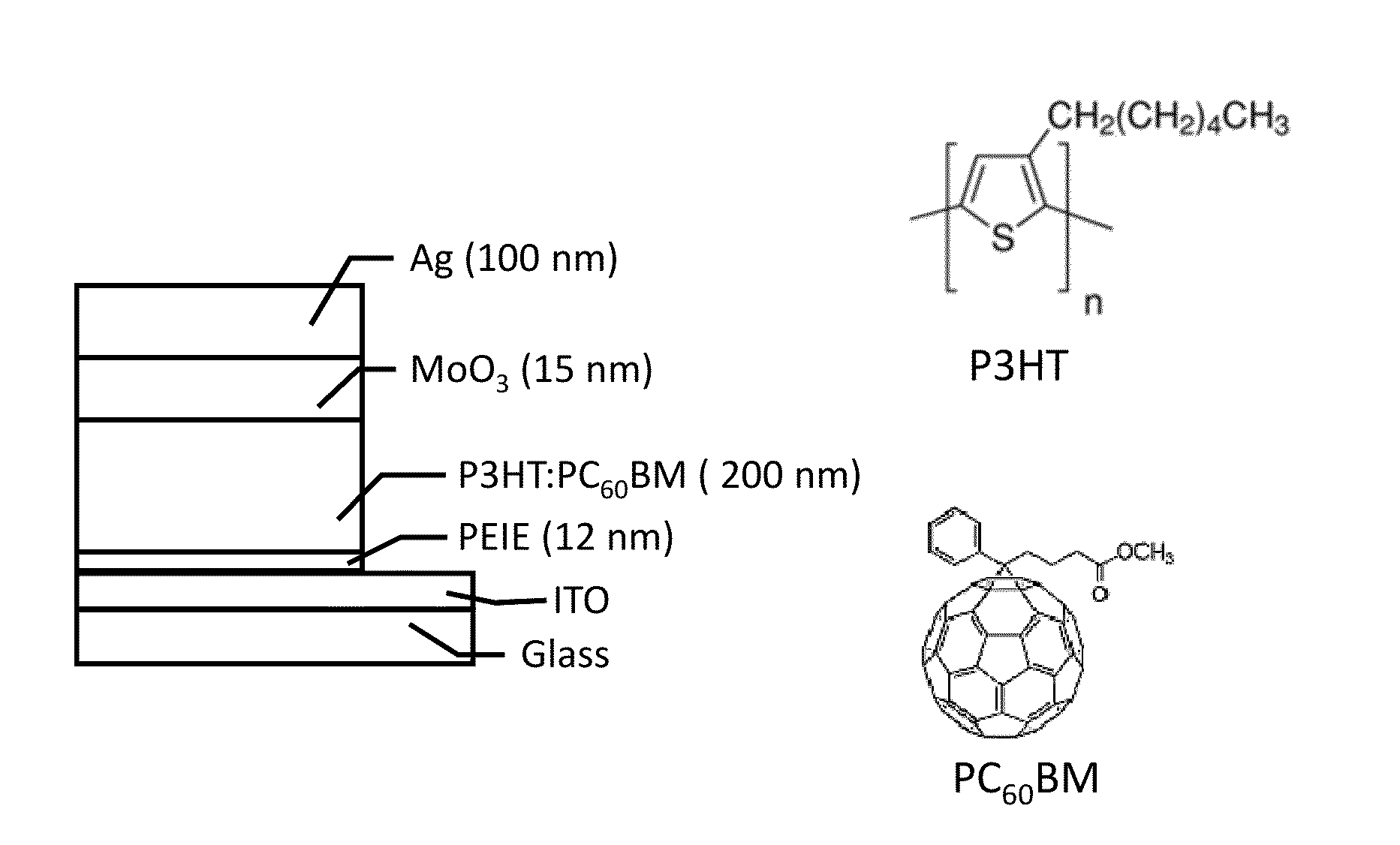Recyclable Organic Solar Cells On Substrates Comprising Cellulose Nanocrystals (CNC)
a technology of organic solar cells and substrates, which is applied in nanoinformatics, pv power plants, manufacturing tools, etc., can solve the problems of less attractive environmental protection, high cost of petroleum-based substrates, etc., and achieve the effect of reducing work functions
- Summary
- Abstract
- Description
- Claims
- Application Information
AI Technical Summary
Benefits of technology
Problems solved by technology
Method used
Image
Examples
examples a1-a8
Use of PEIE to Reduce the Work Function of High Work-Function Electrodes
[0253]FIG. 1 depicts the chemical structure of polyethylenimine ethoxylated (PEIE), which may be utilized to reduce the work function of high work-function electrodes, according to exemplary embodiments of the invention.
Example A1
Work Function Reduction of Indium Tin Oxide (ITO) by PEIE
[0254]FIG. 2 shows the measured work function reduction of indium tin oxide (ITO) modified by different thickness of PEIE, according to exemplary embodiments of the invention.
[0255]In experiments, Indium tin oxide (ITO)-coated glass substrates (Colorado Concept Coatings LLC) with a sheet resistivity of ˜15 Ω / sq were cleaned in an ultrasonic bath of detergent water, rinsed with deionized water, and then cleaned in sequential ultrasonic baths of deionized water, acetone, and isopropanol. Each ultrasonic bath lasted for 20 minutes. Nitrogen was used to dry the substrates after each of the last three baths. For some ITO substrates, O2...
example a8-a12
Characterization of PEIE-Modified Electrodes by UPS and XPS
Example A8
ITO (without Plasma Treatment) Modified by PEIE
[0278]Polyethylenimine, 80% ethoxylated (PEIE) (Mw=70,000 g / mol), which was dissolved in H2O with a concentration of 35-40 wt. % when received from Aldrich, was diluted into methoxyethanol to the weight concentration of 0.5% or 0.05%. It was spin coated onto the ITO substrates at a speed of 5000 rpm for 1 min, yielding a thickness of 1.6 nm and 12 nm, respectively. Then these samples were transferred into an ultra-high vacuum (UHV) analysis chamber to conduct UPS and XPS measurements. He I (21.22 eV) radiation line from a discharge lamp was used in UPS, with an experimental resolution of 0.15 eV. For composition and chemical analysis the films were measured by XPS using the Al Ka (1486.6 eV) photon line with a spectral resolution of 0.8 eV.
[0279]FIG. 4 shows an ultraviolet photoelectron spectroscopy (UPS) spectra of ITO, ITO / PEIE (1.6 nm), and ITO / PEIE (12 nm, accordin...
examples b1-b7
Use of PEI to Reduce the Work Function of High Work-Function Electrodes
[0298]FIG. 13 shows a chemical structure of polyethylenimine (PEI), according to an exemplary embodiment of the invention. The following examples show the work function reduction of an electrode coated with PEI, according to exemplary embodiments of the invention.
Example B1
Work Function Reduction of ITO by PEI with Different Molecular Weight
[0299]Indium tin oxide (ITO)-coated glass (Colorado Concept Coatings LLC) with a sheet resistivity of ˜15 Ω / sq was used as substrate. The substrates were cleaned in an ultrasonic bath of detergent water, rinsed with deionized water, and then cleaned in sequential ultrasonic baths of deionized water, acetone, and isopropanol. Each ultrasonic bath lasted for 20 minutes. Nitrogen was used to dry the substrates after each of the last three baths.
[0300]Polyethylenimine (PEI, branched, from Aldrich) with different molecular weight of 2000 g / mol, 25000 g / mol and 750000 g / mol, was dil...
PUM
| Property | Measurement | Unit |
|---|---|---|
| Work function | aaaaa | aaaaa |
| Temperature | aaaaa | aaaaa |
| Polarity | aaaaa | aaaaa |
Abstract
Description
Claims
Application Information
 Login to View More
Login to View More - R&D
- Intellectual Property
- Life Sciences
- Materials
- Tech Scout
- Unparalleled Data Quality
- Higher Quality Content
- 60% Fewer Hallucinations
Browse by: Latest US Patents, China's latest patents, Technical Efficacy Thesaurus, Application Domain, Technology Topic, Popular Technical Reports.
© 2025 PatSnap. All rights reserved.Legal|Privacy policy|Modern Slavery Act Transparency Statement|Sitemap|About US| Contact US: help@patsnap.com



